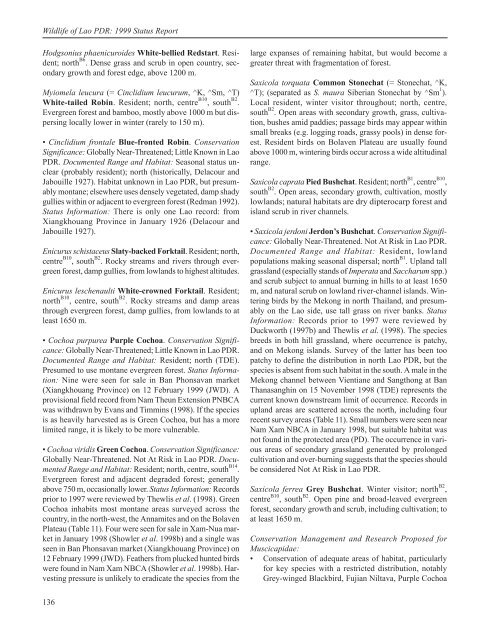Wildlife of Lao PDR: 1999 Status Report - IUCN
Wildlife of Lao PDR: 1999 Status Report - IUCN
Wildlife of Lao PDR: 1999 Status Report - IUCN
Create successful ePaper yourself
Turn your PDF publications into a flip-book with our unique Google optimized e-Paper software.
<strong>Wildlife</strong> <strong>of</strong> <strong>Lao</strong> <strong>PDR</strong>: <strong>1999</strong> <strong>Status</strong> <strong>Report</strong><br />
Hodgsonius phaenicuroides White-bellied Redstart. Resident;<br />
north B6 . Dense grass and scrub in open country, secondary<br />
growth and forest edge, above 1200 m.<br />
Myiomela leucura (= Cinclidium leucurum, ^K, ^Sm, ^T)<br />
White-tailed Robin. Resident; north, centre B10 , south B2 .<br />
Evergreen forest and bamboo, mostly above 1000 m but dispersing<br />
locally lower in winter (rarely to 150 m).<br />
• Cinclidium frontale Blue-fronted Robin. Conservation<br />
Significance: Globally Near-Threatened; Little Known in <strong>Lao</strong><br />
<strong>PDR</strong>. Documented Range and Habitat: Seasonal status unclear<br />
(probably resident); north (historically, Delacour and<br />
Jabouille 1927). Habitat unknown in <strong>Lao</strong> <strong>PDR</strong>, but presumably<br />
montane; elsewhere uses densely vegetated, damp shady<br />
gullies within or adjacent to evergreen forest (Redman 1992).<br />
<strong>Status</strong> Information: There is only one <strong>Lao</strong> record: from<br />
Xiangkhouang Province in January 1926 (Delacour and<br />
Jabouille 1927).<br />
Enicurus schistaceus Slaty-backed Forktail. Resident; north,<br />
centre B10 , south B2 . Rocky streams and rivers through evergreen<br />
forest, damp gullies, from lowlands to highest altitudes.<br />
Enicurus leschenaulti White-crowned Forktail. Resident;<br />
north B10 , centre, south B2 . Rocky streams and damp areas<br />
through evergreen forest, damp gullies, from lowlands to at<br />
least 1650 m.<br />
• Cochoa purpurea Purple Cochoa. Conservation Significance:<br />
Globally Near-Threatened; Little Known in <strong>Lao</strong> <strong>PDR</strong>.<br />
Documented Range and Habitat: Resident; north (TDE).<br />
Presumed to use montane evergreen forest. <strong>Status</strong> Information:<br />
Nine were seen for sale in Ban Phonsavan market<br />
(Xiangkhouang Province) on 12 February <strong>1999</strong> (JWD). A<br />
provisional field record from Nam Theun Extension PNBCA<br />
was withdrawn by Evans and Timmins (1998). If the species<br />
is as heavily harvested as is Green Cochoa, but has a more<br />
limited range, it is likely to be more vulnerable.<br />
• Cochoa viridis Green Cochoa. Conservation Significance:<br />
Globally Near-Threatened. Not At Risk in <strong>Lao</strong> <strong>PDR</strong>. Documented<br />
Range and Habitat: Resident; north, centre, south B14 .<br />
Evergreen forest and adjacent degraded forest; generally<br />
above 750 m, occasionally lower. <strong>Status</strong> Information: Records<br />
prior to 1997 were reviewed by Thewlis et al. (1998). Green<br />
Cochoa inhabits most montane areas surveyed across the<br />
country, in the north-west, the Annamites and on the Bolaven<br />
Plateau (Table 11). Four were seen for sale in Xam-Nua market<br />
in January 1998 (Showler et al. 1998b) and a single was<br />
seen in Ban Phonsavan market (Xiangkhouang Province) on<br />
12 February <strong>1999</strong> (JWD). Feathers from plucked hunted birds<br />
were found in Nam Xam NBCA (Showler et al. 1998b). Harvesting<br />
pressure is unlikely to eradicate the species from the<br />
136<br />
large expanses <strong>of</strong> remaining habitat, but would become a<br />
greater threat with fragmentation <strong>of</strong> forest.<br />
Saxicola torquata Common Stonechat (= Stonechat, ^K,<br />
^T); (separated as S. maura Siberian Stonechat by ^Sm 1 ).<br />
Local resident, winter visitor throughout; north, centre,<br />
south B2 . Open areas with secondary growth, grass, cultivation,<br />
bushes amid paddies; passage birds may appear within<br />
small breaks (e.g. logging roads, grassy pools) in dense forest.<br />
Resident birds on Bolaven Plateau are usually found<br />
above 1000 m, wintering birds occur across a wide altitudinal<br />
range.<br />
Saxicola caprata Pied Bushchat. Resident; north B1 , centre B10 ,<br />
south B2 . Open areas, secondary growth, cultivation, mostly<br />
lowlands; natural habitats are dry dipterocarp forest and<br />
island scrub in river channels.<br />
• Saxicola jerdoni Jerdon’s Bushchat. Conservation Significance:<br />
Globally Near-Threatened. Not At Risk in <strong>Lao</strong> <strong>PDR</strong>.<br />
Documented Range and Habitat: Resident, lowland<br />
populations making seasonal dispersal; north B1 . Upland tall<br />
grassland (especially stands <strong>of</strong> Imperata and Saccharum spp.)<br />
and scrub subject to annual burning in hills to at least 1650<br />
m, and natural scrub on lowland river-channel islands. Wintering<br />
birds by the Mekong in north Thailand, and presumably<br />
on the <strong>Lao</strong> side, use tall grass on river banks. <strong>Status</strong><br />
Information: Records prior to 1997 were reviewed by<br />
Duckworth (1997b) and Thewlis et al. (1998). The species<br />
breeds in both hill grassland, where occurrence is patchy,<br />
and on Mekong islands. Survey <strong>of</strong> the latter has been too<br />
patchy to define the distribution in north <strong>Lao</strong> <strong>PDR</strong>, but the<br />
species is absent from such habitat in the south. A male in the<br />
Mekong channel between Vientiane and Sangthong at Ban<br />
Thanasanghin on 15 November 1998 (TDE) represents the<br />
current known downstream limit <strong>of</strong> occurrence. Records in<br />
upland areas are scattered across the north, including four<br />
recent survey areas (Table 11). Small numbers were seen near<br />
Nam Xam NBCA in January 1998, but suitable habitat was<br />
not found in the protected area (PD). The occurrence in various<br />
areas <strong>of</strong> secondary grassland generated by prolonged<br />
cultivation and over-burning suggests that the species should<br />
be considered Not At Risk in <strong>Lao</strong> <strong>PDR</strong>.<br />
Saxicola ferrea Grey Bushchat. Winter visitor; north B2 ,<br />
centre B10 , south B2 . Open pine and broad-leaved evergreen<br />
forest, secondary growth and scrub, including cultivation; to<br />
at least 1650 m.<br />
Conservation Management and Research Proposed for<br />
Muscicapidae:<br />
• Conservation <strong>of</strong> adequate areas <strong>of</strong> habitat, particularly<br />
for key species with a restricted distribution, notably<br />
Grey-winged Blackbird, Fujian Niltava, Purple Cochoa

















